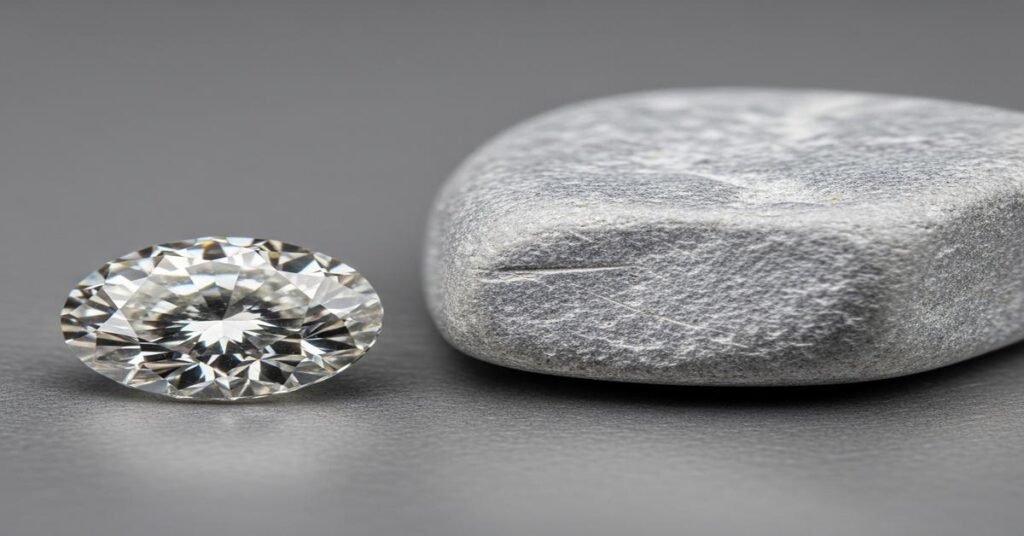The Mohs scale is the standard tool jewelers use to describe how easily a gemstone can be scratched. It ranks minerals from 1 (very soft) to 10 (very hard). Knowing a gem’s Mohs value tells you how it will stand up to everyday wear, cleaning, and accidental knocks. This matters when you choose settings, wear jewelry daily, or decide how to clean and store your pieces.
What the Mohs scale actually measures
The Mohs scale measures scratch resistance: whether one mineral will leave a visible scratch on another. It is an ordinal scale, not linear. That means the jump from 9 to 10 (corundum to diamond) is far larger in real hardness than the jump from 6 to 7. Mohs does not measure toughness (resistance to chipping or breaking) or cleavage (how a gem splits under impact). A gem can be very hard but also brittle, and vice versa. For example, diamond is the hardest (10) but can cleave if struck the right way. Emeralds are relatively hard (about 7.5–8) but often brittle because of internal fractures and inclusions.
Common gems and their Mohs values
- Diamond — 10: Ultimate scratch resistance. Can be scratched only by another diamond.
- Corundum (ruby, sapphire) — 9: Excellent for daily wear. Rarely scratches and resists abrasion well.
- Chrysoberyl (alexandrite) — 8.5: Very durable and good for rings.
- Topaz — 8: Hard, but has perfect cleavage—can split under a hard knock.
- Beryl (emerald, aquamarine) — 7.5–8: Hard enough for many uses, but emeralds often contain fractures and are frequently fracture‑filled.
- Quartz (amethyst, citrine) — 7: Reasonably durable. Fine for pendants and many rings with care.
- Jade (jadeite, nephrite) — 6.5–7: Tough in the case of nephrite; good for carvings and beads, less ideal for everyday rings.
- Feldspar (moonstone, labradorite) — 6–6.5: Prone to scratching and should be worn with care.
- Opal — 5–6.5: Soft and brittle; sensitive to heat, chemicals, and rapid humidity changes.
- Turquoise, Lapis — 5–6: Often stabilized for jewelry; still scratch-prone and soft.
- Pearl — 2.5–4.5: Very soft; scratches easily and can be damaged by acids and abrasion.
How Mohs affects jewelry choices
Pick gems for their expected use, not just beauty. Here are practical guidelines:
- Daily-wear rings (engagement/wedding): Choose gems rated 8 and up when possible—diamond (10), sapphire/ruby (9), chrysoberyl (8.5), topaz (8) with caveats. These withstand daily knocks and contact with metal and surfaces.
- Occasional rings or dress jewelry: Gems rated 6–7 (quartz, some beryls, jade) are acceptable if you remove them for heavy work, sports, or gardening.
- Pendants and earrings: Safer places for softer gems (opal, pearl, turquoise). They experience fewer direct impacts.
- Bracelets: High-contact area. Prefer gems 8+ or protective settings because bracelets hit surfaces often.
Setting and protection strategies
Settings can compensate for lower hardness or poor toughness.
- Bezel settings: Surround the stone’s edge completely. Best for soft or brittle gems like opal, fracture‑filled emeralds, and cabochons. A 6 mm opal in a bezel is far less likely to chip than in exposed prongs.
- Prongs with lower profile: Use short, sturdy prongs for hard stones that still risk chipping at edges. For example, a 1 ct (approx. 6.5 mm) sapphire in four substantial prongs reduces exposure.
- Low-set designs: Rings set close to the finger reduce catch and impact for softer gems.
- Halo or protective collars: Surround a softer center with harder accent stones (e.g., small diamonds) to shield edges.
Care and cleaning by gem type
Cleaning choices depend on Mohs hardness and treatments.
- Hard stones (8–10): Most tolerate ultrasonic and steam cleaning (diamond, corundum), but confirm there are no cracks or treatments that could be damaged.
- Medium hardness (6–7.5): Use warm water, mild soap, and a soft brush. Ultrasonic cleaning can be risky if the gem has fractures or cavities (e.g., emeralds).
- Soft/brittle gems (under 6): Avoid ultrasonic and steam. Clean with a soft cloth and mild soap. Avoid sudden temperature changes and chemicals (opals and pearls are sensitive to both).
- Fracture‑filled, surface‑coated, or dyed stones: These can lose treatments with heat, solvents, or ultrasonic cleaning. Ask the seller for treatment details before cleaning.
Storage and everyday precautions
Prevent scratches by separating pieces. Hard stones can scratch softer ones even while stored.
- Store jewelry in individual soft pouches or separate compartments in a jewelry box.
- Remove rings for manual labor, gardening, and sports. Even a 9 (sapphire) can chip under forceful blows.
- Avoid chemicals: chlorine weakens gold alloys and can damage some gem treatments. Remove jewelry for pool or heavy cleaning work.
- Have settings checked: prongs loosen, increasing the chance of loss or impact damage. Check annually or after knocks.
How to use Mohs wisely — practical rules of thumb
- Do not scratch-test at home. It damages gems and voids seller return policies. Use certified reports for hardness and treatments.
- Assume harder stones scratch softer ones. A sapphire (9) will scratch gold and softer gems it rubs against over time.
- Prioritize toughness for active wearers. A tough, slightly softer gem with good protection can outperform a hard but brittle stone for daily life.
- When in doubt, protect it. Bezel settings, low profiles, and removing jewelry during risky activities extend the life of any gem.
Understanding Mohs will help you match a gem to how you live. Hardness tells you about scratch resistance, but you must also consider toughness, treatments, and setting. Choose the right combination of gem, setting, and care to keep your jewelry beautiful for years.
I am G S Sachin, a gemologist with a Diploma in Polished Diamond Grading from KGK Academy, Jaipur. I love writing about jewelry, gems, and diamonds, and I share simple, honest reviews and easy buying tips on JewellersReviews.com to help you choose pieces you’ll love with confidence.

